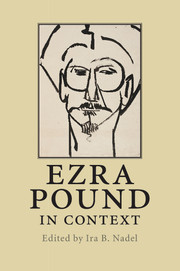Book contents
- Frontmatter
- Contents
- Notes on contributors
- Acknowledgements
- Chronology
- List of abbreviations and note on references to The Cantos
- Introduction
- Part I Biography and works
- 1 Prose criticism
- 2 Poetics
- 3 Translation
- 4 Romance languages
- 5 Letters
- 6 Editor, anthologist
- 7 Education
- 8 Journalism
- 9 Politics
- 10 Economics
- 11 Radio broadcasts
- 12 Law
- 13 Textual criticism
- 14 Archives
- 15 The Lives of Pound
- Part II Historical and cultural context
- Part III Critical reception
- Further reading
- Index
4 - Romance languages
Published online by Cambridge University Press: 05 July 2014
- Frontmatter
- Contents
- Notes on contributors
- Acknowledgements
- Chronology
- List of abbreviations and note on references to The Cantos
- Introduction
- Part I Biography and works
- 1 Prose criticism
- 2 Poetics
- 3 Translation
- 4 Romance languages
- 5 Letters
- 6 Editor, anthologist
- 7 Education
- 8 Journalism
- 9 Politics
- 10 Economics
- 11 Radio broadcasts
- 12 Law
- 13 Textual criticism
- 14 Archives
- 15 The Lives of Pound
- Part II Historical and cultural context
- Part III Critical reception
- Further reading
- Index
Summary
In “Medievalism,” his 1928 essay on Guido Cavalcanti, Ezra Pound described the uniqueness of medieval Italian poetry. The poets of this time, he writes “brought into poetry something which had not been in any so marked and developed degree in the poetry of the troubadours. It is still more important for any one wishing to have well-balanced critical appreciation of poetry in general to understand that this quality, or this assertion of value, has not been in poetry since” (LE, 150). This quality, he claimed, had its origin in the troubadours’ shift from the classical aesthetic of “[p]lastic plus immediate satisfaction,” to the “dogma that there is some proportion between the fine thing held in the mind and the inferior thing ready for instant consumption” (LE, 151). For Pound, the aesthetic shift initiated by the troubadours achieved its fullest expression in the Tuscan poetry of the trecento which “demand[ed] harmony in something more than the plastic” (LE, 151) and gave central importance to the interaction between the intellect and the senses. This poetic sensibility, he came to believe, found its most perfect expression in Cavalcanti's canzone “Donna mi prega,” a poem for which he gained increasing admiration over the course of almost three decades of study.
Pound's first serious encounter with Cavalcanti's poetry likely came when he was a student at Hamilton College, between 1903 and 1905. In 1910 Cavalcanti appeared as part of his description of Tuscan poetry in The Spirit of Romance, and in 1912 Pound published translations of some fifty of his poems under the title Sonnets and Ballate of Guido Cavalcanti. Then, a decade and a half later, he began to take particular interest in “Donna mi prega,” publishing critical essays on the poem and translating it twice. The second of these translations appeared as part of Canto xxxvi, where it stands as what Hugh Kenner called “a model of focused intellection and passion” (PE, 424).
- Type
- Chapter
- Information
- Ezra Pound in Context , pp. 43 - 53Publisher: Cambridge University PressPrint publication year: 2010
- 1
- Cited by

